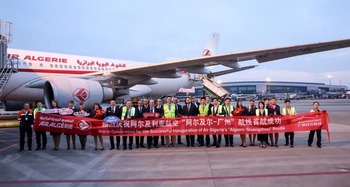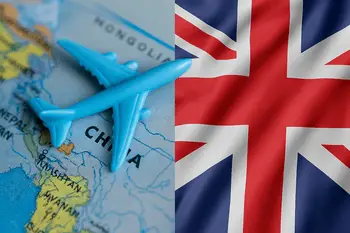
On the night of October 28, 2025, Air Algérie Flight AH3180 touched down at Guangzhou Baiyun International Airport, marking the inaugural direct connection between Algiers, the capital of Algeria, and Guangzhou, one of China’s largest and most dynamic southern gateways.
This new long-haul route — spanning roughly 10,000 kilometers — does more than shorten travel time: it symbolically reconnects ancient trade pathways and practically expands opportunities in commerce, tourism, education, and cultural exchange between North Africa and southern China.
This article explores the significance of the route, how it fits within broader aviation and geopolitical trends, what travelers and businesses should expect, and practical tips for planning travel between Algeria and Guangzhou.
Why the Route Matters
The establishment of a direct air corridor between Algiers and Guangzhou matters on several levels: strategic aviation network growth, economic ties, tourism potential, and people-to-people exchange.
- Strategic network growth: Guangzhou Baiyun Airport is positioning itself as a comprehensive international hub for southern China, increasing its reach into new markets. Adding Algiers strengthens Guangzhou’s network into North Africa and complements existing services to Europe, the Middle East, and Southeast Asia.
- Economic ties: Direct flights reduce transit time, lower logistics friction for high-value trade, and make business travel more viable for SMEs and regional investors. For exporters in sectors like electronics, textiles, and agricultural goods, a direct link can lower overall transaction costs and speed negotiations.
- Tourism and cultural exchange: Algeria’s diverse landscapes — Mediterranean coastlines, Roman ruins, Saharan vistas — become more accessible to Chinese tourists. At the same time, Guangdong’s manufacturing hubs and cultural offerings become easier for Algerians to visit.
- Geopolitical and soft-power connectivity: The route is a practical manifestation of expanding bilateral relations and regional diplomacy, creating opportunities for collaboration on education, technology, and cultural projects.
Air Algérie and Guangzhou Baiyun Airport: Context
Air Algérie’s launch of a nonstop Algiers–Guangzhou flight expands the airline’s global footprint and signals Algeria’s interest in stronger ties with East Asia.
Guangzhou Baiyun International Airport, already a major node in China’s civil aviation, has in 2025 pursued an aggressive expansion of its international route map, adding, restoring, and increasing frequencies on over 30 international passenger routes and attracting carriers like Astana, Bamboo Airways, and Nepal Airlines.
This new route exemplifies two simultaneous trends:
- The decentralization of long-haul services away from a handful of global hubs toward more diverse city pairs
- Airlines recalibrating networks post-pandemic to match renewed demand for both business and leisure travel.
For Guangzhou, the Algiers link strengthens its role as a “southern gateway” for trade and tourism with new reach into Africa.
Flight and Travel Details
Below is a compact summary table of the key operational and traveler-focused details for the Algiers–Guangzhou route.
| Operator | Air Algérie |
| Flight number (inaugural) | AH3180 |
| Route | Algiers (ALG) — Guangzhou (CAN) |
| Distance | Approximately 10,000 km |
| Typical flight time | Around 12–14 hours depending on routing and winds |
| Frequency | Mon, Wed & Fri |
| Departure/Arrival airports | Houari Boumediene Airport (Algiers) ; Guangzhou Baiyun International Airport |
| Time difference | Guangzhou is 7 hours ahead of Algiers |
| Currency (local) | Algeria: Algerian dinar (DZD) ; China: Renminbi (CNY) |
Sources and external links: https://www.airalgerie.dz https://www.gzairport.com/en
Notes about the table
- Flight times and frequencies are indicative; travelers should verify exact schedules with the carrier.
- Currency and time-difference facts help with itinerary planning and communication across time zones.
Practical Travel Advice
Visas and Entry Requirements (General Guidance)
- Algerian and Chinese visa policies can change. Travelers should consult official government or consulate resources before booking. In many cases, business travelers and tourists must secure visas in advance unless specific visa-exemption arrangements apply.
- Carry all required documents: passport valid for at least six months, return or onward ticket, proof of accommodation, and supporting documents for business travelers (invitation letters, industry registration, etc.).
Currency and Money
- Algeria’s official currency is the Algerian dinar (DZD). Chinese visitors should plan to exchange currency prior to departure or use major international currencies convertible in Algerian banks and official exchange counters.
- In Guangzhou, cashless payments (mobile wallets such as Alipay and WeChat Pay) are extremely common; international visitors should prepare a payment strategy — carry some cash or obtain a bank card compatible with Chinese networks.
Health and Safety
- Verify vaccination and health-entry requirements well before travel; some countries may have updated health screening protocols.
- Travel insurance that covers medical evacuation and flight disruption is recommended for long-haul itineraries.
Timing and Jet Lag
Guangzhou is 7 hours ahead of Algiers. Allow at least two days for adaptation when traveling in either direction, especially when scheduling business meetings.
Tourism Highlights: Why Visit Algeria
Algeria offers a compact but diverse set of cultural and natural attractions that will appeal to different traveler types.
The direct flight simplifies itineraries and reduces transit hassles, making multi-destination North African itineraries more feasible.
Constantine: The Bridge City
Constantine’s nickname, “the bridge city,” arises from its dramatic location perched above deep gorges and connected by multiple historical bridges.
Visitors appreciate panoramic views, old stone streets, and a palpable layer of history in the architecture and urban fabric.
Timgad: Roman Ruins
Timgad features one of the best-preserved Roman grid-plan cities in North Africa, with monumental gates, a theater that once seated thousands, and public buildings that evoke the grandeur of Roman urbanism.
It’s an essential stop for lovers of antiquity.
Oran and the Notre-Dame d’Afrique
Oran’s coastal position offers both Mediterranean charm and historical layers from Spanish and French periods.
The Notre-Dame d’Afrique, a 19th-century basilica built in Roman-Byzantine style, sits above the bay and provides sweeping views of the city and sea.
Sahara Interior
For adventurous travelers, the Sahara in Algeria offers tranquil dunes, star-filled skies, and unique nomadic cultures.
Popular desert experiences include camel treks, 4×4 expeditions, and photography tours of striking desert landscapes.
Business and Trade Opportunities
The new route has immediate commercial implications:
- Exporters can explore time-sensitive shipping possibilities for value-added goods that benefit from reduced transit time.
- Guangdong manufacturing and trading communities gain simpler access to North African markets for machinery, textiles, automotive parts, and consumer electronics.
- Firms interested in African raw materials and agricultural products can pursue closer supplier relationships with face-to-face negotiations enabled by direct connectivity.
- Logistics providers and freight forwarders may study opportunities to develop hub-and-spoke models using Guangzhou as a gateway for southern China-Africa trade lanes.
Cultural and Educational Exchange
Direct flights make student exchanges, academic collaboration, and cultural events more manageable.
Universities and cultural institutions in Guangdong and Algeria can more readily host visiting delegations, short-term exchange students, and joint research programs — particularly in fields such as environmental studies, desert ecology, history, and trade logistics.
Airport and Ground Connections in Guangzhou
Guangzhou Baiyun International Airport continues to expand its ground transport integration.
Travelers arriving on the Algiers flight can access regional high-speed rail, city metro links, and intercity coach services to neighboring cities such as Shenzhen and Foshan.
Ground transport improvements enhance the route’s value because passengers can reach the Pearl River Delta’s industrial and commercial zones within a few hours of arrival.
Sample Itineraries
1. Leisure-focused 10-day Algeria Highlights
- Day 1–2: Arrive Algiers; explore Casbah, promenades, and museums
- Day 3–4: Fly/drive to Constantine; visit bridges and old town
- Day 5–6: Travel to Timgad and Roman sites
- Day 7–9: Desert experience in Saharan regions (Timimoun or other options)
- Day 10: Return to Algiers for departure
2. Business short-stay (Guangzhou to Algiers, 5 days)
- Day 1: Depart Guangzhou evening; overnight on flight
- Day 2: Morning arrival, check-in, afternoon meetings
- Day 3: Business meetings and site visits
- Day 4: Follow-up meetings, networking dinner with local partners
- Day 5: Return flight to Guangzhou
Adjust itineraries to seasonal weather, local holidays, and airline schedules.
Sustainability and Environmental Considerations
Long-haul flights contribute to aviation emissions, and both airlines and airports are increasingly under pressure to adopt greener practices.
Travelers and businesses should be aware of emerging carbon-offset programs, fuel-efficiency improvements from modern aircraft, and airport initiatives (e.g., energy-efficient ground operations).
When possible, consider offsetting emissions through reputable programs and choosing carriers that disclose sustainability measures.
Risks and Considerations
- Political and regulatory changes: Aviation routes can be affected by diplomatic relations, air service agreements, and security considerations. Monitor official notices from authorities.
- Seasonal weather: Sandstorms in Saharan regions and regional weather events can affect ground travel and inland flights; have flexible plans.
- Connectivity limitations within Algeria: Domestic flight frequency and ground infrastructure vary by region. For remote destinations, expect longer surface travel times.
How This Fits into Broader Aviation Trends
The Algiers–Guangzhou link reflects a post-pandemic reconfiguration of long-haul networks: carriers and airports are exploring more direct city-pair services to capture underserved demand, bypassing traditional hub-and-spoke constraints.
This move is consistent with several global trends:
- Increased demand for point-to-point long-haul travel among leisure and diaspora markets.
- The strategic push by regional airports to diversify international origin-destination pairs.
- National carriers expanding bilateral reach to support economic diplomacy.
Traveler Checklist Before Booking
- Confirm passport validity (usually six months or more)
- Check visa requirements with consulates or official portals
- Review airline baggage allowances for long-haul flights
- Arrange travel insurance covering medical and trip disruptions
- Plan local transport from arrival airport to final destination
- Prepare currency (some vendors accept only local currency)
Table: Quick Comparison of Key Travel Factors
| Factor | Algiers | Guangzhou |
|---|---|---|
| Time zone relative to UTC | UTC+1 | UTC+8 |
| Major local currency | DZD | CNY |
| Typical weather | Mediterranean coast Continental inland | Subtropical monsoon climate |
| Primary airport | Houari Boumediene Airport | Guangzhou Baiyun International Airport |
| Language | Arabic Tamazight French commonly used | Mandarin Cantonese commonly used |
Sources and external links: https://www.gzhairport.com https://www.airalgerie.dz https://www.algeria.com/travel
Final Thoughts
The inaugural Algiers–Guangzhou direct flight is more than a new itinerary line on a map.
It is a concrete facilitator of trade, tourism, academic exchange, and cultural connectivity between North Africa and southern China.
For businesses, it opens more efficient channels to explore joint ventures and sourcing.
For travelers, it renders previously cumbersome itineraries straightforward and invites discovery of Algeria’s underappreciated natural and historical riches.
For policymakers and airport strategists, the route underscores the value of targeted route development in enhancing a city’s global accessibility.
As with any new long-haul service, success depends on sustained demand, competitive pricing, visa facilitation, and efficient ground connections.
Travelers and companies interested in leveraging this new route should monitor airline schedules, visa policy updates, and seasonal tourism patterns to plan effectively.
Where to get more information
For operational updates, ticketing, and the most current entry guidance, consult the official airline and airport websites listed below.
Local consulate and immigration services provide definitive visa and entry requirements.
Useful Links
- Air Algérie official site: https://www.airalgerie.dz
- Guangzhou Baiyun International Airport: https://www.gzairport.com/en
- Algeria tourism overview: https://www.algeria.com/travel


